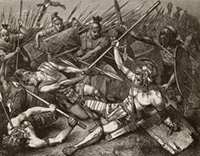Crucifixion in History
History is unclear as to the origin of crucifixion, but many believe it to have originated with the ancient Assyrians. The brutal, war-like character of the Assyrians certainly make this a tenable supposition. Other early recorded instances of crucifixion occurred in the Persian Empire. The Persians, who ruled over a large territory that included modern-day Iran, Iraq, and Afghanistan, are thought to have adopted the practice from the aforementioned Assyrians.

It appears that the practice was passed on to succeeding conquerors when each great empire acquired dominance. Evidence suggests that Alexander the Great may well have borrowed the practice from the Persians when they became his vassals and introduced it in battles with the Carthaginians. Livy recorded that later, during the Punic Wars between Carthage and Rome, Carthaginian general Hannibal crucified 500 Roman prisoners after defeating them in battle. This act is thought to have inspired the Romans to use crucifixion as punishment thereafter.
Crucifixion was first used extensively by the Roman military during the 1st century BC, however, and was primarily employed to punish rebellious soldiers and enemy fighters. It became more widespread in use during the reign of Emperor Augustus Caesar, who used it to punish criminals and political dissenters.
Notable Mass Executions
Emperor Darius I of Persia ordered the crucifixion of 3,000 political prisoners in Babylon during the 6th century BC.
Seleucid king Antiochus IV Epiphanes attacked Jerusalem in 167 BC, butchering tens of thousands of traditional Jews, many of whom were crucified, (according to Josephus in "Antiquities"). When exacting revenge for rebellion in 88 BC, Hasmonian king Alexander Jannaeus crucified 800 Pharisee rebels while they watched the slaughter of their wives and children.
In his treatise, "War", Josephus describes Syrian governor Publius Quinctilius Varus crucifying 2,600 to suppress unrest following Herod’s death, and in AD 66 Gessius Flores scourged and crucified 3,600. Titus Flavius Caesar tortured and crucified hundreds outside Jerusalem over several days in AD 70 at the time of Jerusalem's destruction.

Perhaps the most famous mass execution of antiquity took place following the Third Servile War of Rome (the slave rebellion under Spartacus). In 71 BC after the end of the war, 6,000 slaves were crucified along the "Via Appia" between Rome and Capua. This created a string of crosses with one placed every one hundred feet for a distance of nearly 120 miles. Slaves were allowed to rot on the crosses to demonstrate to all passers-by the consequences of rebellion.
According to the Romans, the following crimes merited crucifixion:
- desertion to the enemy
- high treason
- rebellion
- murder
- serious falsification of legal documents
- magic
In most cases, those crucified were slaves or foreign Roman subjects. Roman citizens could only be punished this way if they committed high treason or desertion.
During the reign of Emperor Tiberius, crucifixion was reserved for the lowest class of criminals, such as slaves and bandits. However, during the rule of Emperor Nero, (54-68 AD), crucifixion was used more frequently to punish Christians, who were seen as a threat to the Roman Empire.

